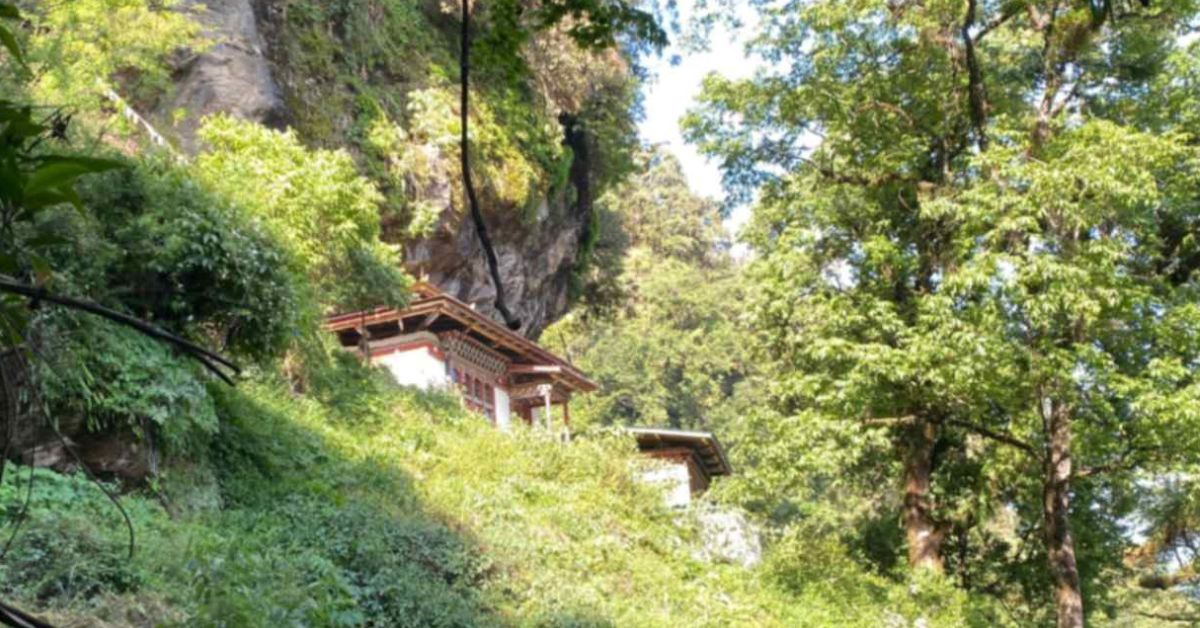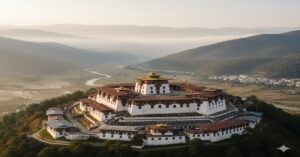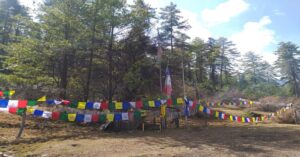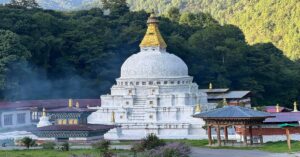Tshechu Dra is one of the “four cliffs” of Guru Rinpoche entrusted to Phajo Drugom Zhigpo in his prophetic vision. This sacred cliff of longevity is located in the Panikong village of Khamaed Gewog under Gasa Dzongkhag at an elevation of 2335 meters above sea level.
Guru Rimpoche flew from Goen Tshephu Ney to Tshechudra, where he is said to have extracted longevity water from a cliff to benefit sentient beings. Tsechu means “longevity water” and Dra means “cliff“. Therefore, Tshechudra translates to a cliff of longevity water.
How to Reach the Tshechu Dra
To reach Tshechudra, you must travel 42 kilometers from Punakha to Panikong village. From Panikon, it takes an hour on foot to Tshechudra Ney.
Sacred Relics to See at Tshechu dra
- A spot to make a mandala offering;
- A cave where Guru Rinpoche meditated;
- Self-arisen letters Ah;
- Guru Rinpoche’s seat;
- Walking Stick of Guru Rinpoche;
- Longevity water or Chimed Tse Duetsi;
- Ney Sarpo;
- The Zangdopelri of Guru Rinpoche.
Also Read: Guru Rinpoche in Bhutan: His Visits to Bhutan and Sacred Sites
Historical Significance of Tshechudra
Tshechudra was blessed by Guru Rinpoche in the 8th century. The sacred cliff was called Duetsi Drak. It is mentioned that “At Duetsi Drak, Guru Rinpoche meditated for one month, during which four Khandroms—female gods—conducted feast offerings to Guru Rimpoche. The ceremony was marked by auspicious signs, such as the drizzling of immortal rain for three days.
Later, Guru Rinpoche entrusted Phajo Drugom Zhigpo with his twelve meditation places. According to the biography of Phajo Drugom Zhigpo, “The Current of Compassion”, Phajo Drugom Zhigpo traveled to Taktsang Senge Samdrup Dzong in the 13th century following a prophetic direction from Tsangpa Gyare. While Phajo was meditating in Taktsang Palphug, Guru Rinpoche appeared to him in an unmistakable clear vision one early morning and said, “I am entrusting to you twelve of my meditation places which consist of four Dzongs (Fortress), four cliffs, and four great caves; you have to plant the Victory Banner of Practice in all of these.”
According to Tshechu Dra’s history, Phajo meditated at Tshechudra for a month, conducting Ganachakra of the Four Types of Khandromas, and for three days, a rain of nectar fell from the sky.
Therefore, Tshechudra is one of the four cliffs out of the twelve meditation places, which consist of four Dzongs, four Cliffs, and four Caves entrusted to Phajo Drugom Zhigpo by Guru Rinpoche. The other three cliffs are Thujidra in Thimphu, Gomdra in Paro, and Dechendrak in Wangdue Phodrang. It is believed that anyone who meditates here will become enlightened.
Description of Panikong
The nearest road point to reach Tshechudra is Panikong village. Here, you can see the holy water sources of Drubthop Nagi Rinchen. There is also a seat of Drubthob nearby. It is said that when Drubthob Nagi Rinchen traveled from Dho Jhaga Lam to Gasa, he reached Panikong village. The local people offered food. While having the food, Drubthob asked for Pani (water). But the place is said to have no water source. So, Drubthob had struck his walking stick and extracted three water sources there. You can still see his cypress walking stick. Therefore, the place came to be known as Panikong.
The other sacred sites associated with Drubthob Naggi Rinchen are a small fortress called Dzong Chung before the construction of Punakha Dzong and Jagar Damkelsa Ney, a cliff where Drubthob meditated to rescue his mother from an ephemeral hell.
Description of Tshechu dra
After traveling for a while from Panikong towards Tshechudra, there is a plain area where the local people offer Goen Zhey during the Tshechudra festival. Here, people offer Marchang and songs to Guru Rinpoche. As you gradually climb up, you will reach the Neygo of Tshechudra, the sacred door to Tshechudra Ney. Here, people offer Marchang to the local deities a day before the Tshechudra festival. From the Neygo, people are not allowed to carry any tobacco products towards Tshechudra Ney. It is believed that many bad omen occurs if one carries it.
You can also see Guru Rinpoche’s Uzha, or the key to Tshechudra Ney. People offer Khadar to the hat before continuing their journey to Tshechudra. After traveling for a while, you reach a waterfall from a small cliff known as Shelkar Dra. It is believed that when Guru Rinpoche came to Tshechudra, the local deities offered this water to him.
From there, you will reach a place called Mendrelgang. It’s a place of Mandala offerings. Here, you can see the whole of Tshechudra Ney. You can see the cliff said to be the Zangdopelri of Guru Rinpoche, the cliff from where Guru extracted the longevity water (Tsechu), and many more. Before proceeding further, people offer a Mandala and prostrate to Tshechudra.
Tshechu Drak
Tshechu Drak is a cliff with a cave where Guru Rinpoche meditated and extracted Tsechu, longevity water, from a cliff to benefit sentient beings. Therefore, Tshechudrak translates to a “cliff of longevity water”.
Just beside the temple, there are many self-arisen letters “Ah“. It is said that treasures are hidden under these letters to be revealed in the future. There is also a walking stick of Guru Rinpoche on a cliff. After walking for a few minutes from the Lhakhang, there is the Ney Sarpo. It is one of the meditation caves of Guru Rinpoche. The way is a bit risky and difficult for older people and children. This sacred cave was discovered much later. The cave is narrow and dark. A torch is a must.
After passing through a tight cave passage, you reach the main cave of Guru Rinpoche. The main cave is large and spacious with the Guru’s footprint, the hearth of Khandro, and many more. During auspicious days and your lucky days, the holy water drips from this cave.
Once you come out of the Ney Sarpo from its exit point, you proceed to the place where there is the seat of Guru Rinpoche, the meditation site called Zangdopelri Phodrang, and the longevity water. The meditation site, Zangdopelri, is mostly inaccessible. It faces Goen Tshephu, from where Guru Rinpoche flew to this meditation site.
The main attraction of Tshechudra is the Chimed Tse Duetsi, or the longevity water of Guru Rinpoche, flowing from the cliff. Therefore, the sacred site came to be known as Tshechudra, the cliff of longevity water. The longevity water is believed to have healing powers, too.
Also Read: The 4 Sacred Cliffs of Guru Rinpoche Entrusted to Phajo Drugom Zhigpo
Tshechu Drak Lhakhang
There was no Lhakhang till 2013. There was only a hermitage of Phajo Drugom Zhigpo. The former minister from Gasa, with the support of Jigme Dorji National Park, built a community Lhakhang. The main statue of Tshechu Drak Lhakhang is Chenrigzi, flanked by Guru Rinpoche and Zhabdrung Rinpoche. Inside the temple, you will see the representative of Guru Rinpoche in the form of a monolith.
Tshechudra Festival
On the 10th day of the 2nd month of the lunar calendar, a Ganachakra Feast Gathering (Tshokhor) rite is celebrated at Tshechudra. Locals of both Chazhi and Goen Tshephu believe that Phajo Drugom Zhigpo stayed there for a month conducting Ganachakra of the Four Types of Khandromas, and for three days, a rain of nectar fell from the sky. The feast gathering is conducted by the villages of Khatoed.
Accommodation at Tshechu Drak
There are village Home Stays in Gasa. You can contact the site managers of Tshechu Drak, Mr. Chado and Mrs. Rinchen, at 17320925 and 17409945 respectively.
Best Time to Visit Tshechu dra
A pilgrimage to Tshechudra can be made at any time of year. It is also possible to go on pilgrimage during the peak summer months, although it is not encouraged due to the unpredictability of the weather in the hilly terrain. Winters are severely cold, and excessive snowfall blocks certain highways, making travel extremely dangerous.
As a result, early spring (March, April, and May) and autumn (September, October, and November) are the best times to visit this sacred cliff of Guru Padmasambhava. You can visit major pilgrimage sites in Gasa with the Bhutan Pilgrimage Package.
Places to Explore in Gasa
Gasa Dzong: Also known as Gasa Tashi Tongmon Dzong, the fortress was built in the 17th century over a meditation site established by Drubthob Terkungpa in the 13th century as a defense against northern attacks in 1646.
Gasa Tshachu: It is a renowned natural hot spring believed to cure ailments such as rheumatism, arthritis, ulcers, and indigestion. The Tshachu features multiple bathhouses and pools with varying water temperatures, attracting local and international visitors.
Enjoyed reading this blog?




